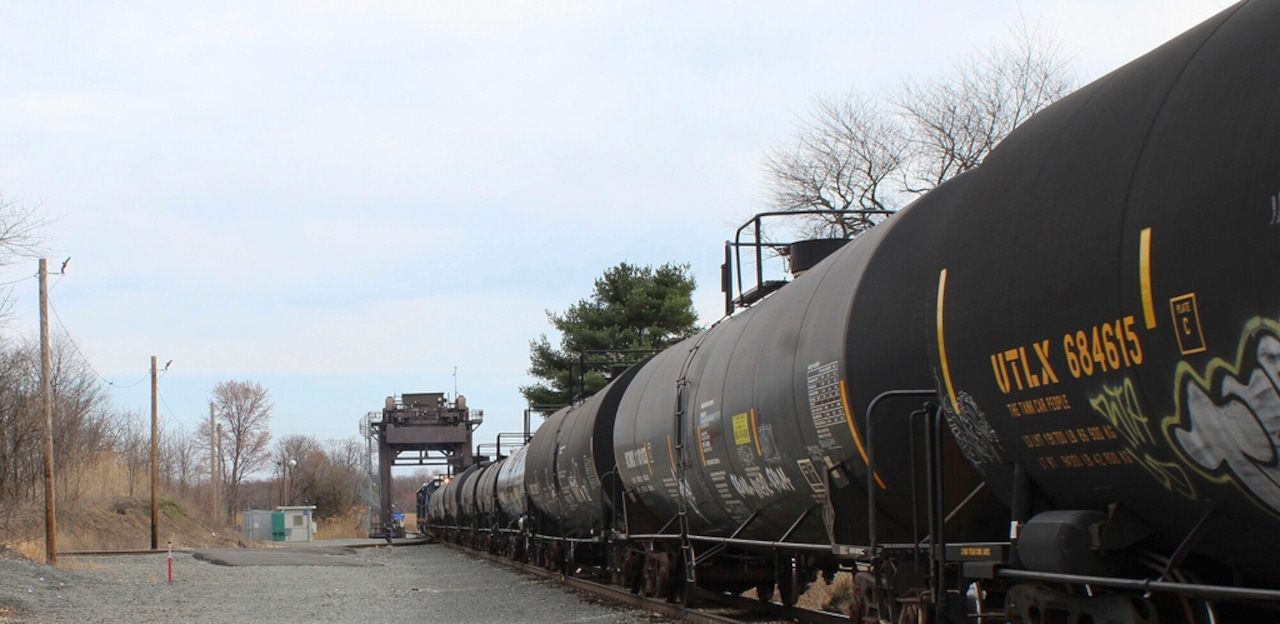Approximately once every two months, a train derails in the United States, spilling at least 1,000 gallons of hazardous materials. Since 2015, a review of federal derailment statistics revealed that nearly half of all derailments led to evacuations, and over a quarter resulted in a fire or explosion.
Additionally, many of the villages that border the rail lines are unprepared to protect people in the event that it occurs.
The Howard Center for Investigative Journalism at the University of Maryland came to that conclusion after reviewing hundreds of rail safety reports and records and speaking with dozens of first responders and industry experts.
Additionally, a network of AI-enhanced video sensors provided the Howard Center with unprecedented access to rail data, enabling reporters to follow hazardous material shipments along 2,200 miles of rail lines between West Texas and the U.S.-Canadian border.
At least 130,000 rail cars with placards for hazardous chemicals traveled over segments of rail lines from Blaine, Washington, to Amarillo, Texas, during the previous six months, according to data given by a private corporation named RailState LLC. The investigation discovered that those vehicles went by more than 1,000 schools, 80 hospitals, and the residences of at least 2.5 million individuals who lived within a mile of the tracks.
According to Jamie Burgess, a hazmat training director at the International Association of Firefighters, it’s reasonable to assume that the majority of communities are unaware of the chemicals that are constantly traveling up and down the railroads in their backyard.
In the early aftermath of a hazardous derailment, first responders frequently lack the knowledge, skills, tools, and thorough planning necessary to react safely.
According to the U.S. Fire Administration, less than one in five fire departments around the country have a dedicated staff of hazmat specialists.
Local firemen depend on a network of assistance from neighboring departments, regional hazmat teams, state and federal officials, and railroad contractors to provide the knowledge and tools they might not have in the event of a catastrophic hazmat derailment. However, such teams may be hours away, so firemen may have to manage the developing situation alone.
In 2023, firefighters with specialized hazardous training took over an hour to reach the scene of a Norfolk Southern train derailing in East Palestine, Ohio.
Paul Stancil, who recently resigned from his position as a senior hazardous materials accident investigator with the National Transportation Safety Board, stated that they are initially overwhelmed since it’s typically the first time they’ve ever dealt with something like this. In East Palestine, that was an issue. It is an issue on practically all websites.
According to industry estimates, at least 80,000 first responders participated in hazmat training programs supported by the railroad sector in 2024. However, according to U.S. Fire Administration statistics, this is only a small portion of the 1 million career and volunteer firemen in the United States.
Rail is the safest way to move hazardous chemicals over land, according to Jessica Kahanek, a spokesman for the Association of American Railroads. In 2024, U.S. railroads successfully transported over 2 million shipments of hazardous commodities.
In the past ten years, there have been 57 derailments that have caused the spill of at least 1,000 gallons (3,800 liters) of hazardous material, according to a Howard Center review of federal statistics. Of the derailments, 16 ended in fires or explosions, while 26 led to evacuations.
Firefighters dispatched to the scene of such derailments frequently encounter a serious issue: Many are unaware of the chemicals on board and the potential exposure concerns. Additionally, the need to provide that information right now has been postponed by federal authorities.
This month, East Palestine Fire Chief Keith Drabick wrote to federal authorities to express his disapproval of the delay and to request that they impose a more stringent schedule on railroads.
According to Drabick, the East Palestine derailment in my village in 2023 brought to light a serious deficiency in prompt public safety communication on information pertaining to hazardous chemicals involved in rail emergencies. “I’m worried that the derailment in my community could happen again if regulators don’t enforce it strictly,” he continued.
We were untrained … we were ill prepared
Communities may suffer severe repercussions if they are not ready for a hazardous spill.
Several tank cars carrying vinyl chloride, a highly dangerous and combustible chemical, fell into a creek in Paulsboro, New Jersey, in 2012 after a derailment. A cloud of poisonous gas filled the surrounding area when one of the tank cars burst open.
At first, local police and volunteer firefighters approached the wreck without breathing apparatus, even standing in the cloud, because they were perplexed by the chemical that had been discharged. Investigators later discovered that many local residents waited hours in the exposure zone since the original evacuation area was too limited.
Symptoms of chemical exposure were reported by over 700 residents and responders.
According to a later NTSB assessment, the accident’s severity was exacerbated by the inadequate emergency response.
Chris Wachter, the police chief for Paulsboro at the time of the disaster, stated, “We’ve never experienced anything of this magnitude in my entire career.” We lacked the necessary training. We weren’t ready for it.
Fire authorities in Paulsboro refused to be interviewed for this article. Gloucester County emergency authorities, who also declined to be interviewed, stated in an emailed statement that the county’s Hazardous Materials Team’s skills and connections with local first responder organizations have significantly improved.
Only a small portion of the dangerous substances that frequently travel on the trains are represented by vinyl chloride. According to a Howard Center examination of RailState data, the most dangerous chemicals transported by train, aside from alcohol and petroleum, are sulfuric acid, chlorine, hydrochloric acid, and ammonia. All of these substances are extremely poisonous and can be fatal in large doses.
A crucial component of PVC plastic, which is utilized in building and packaging goods, is vinyl chloride. In water treatment facilities around the United States, chlorine is a common disinfectant. Fertilizer used on farms is made of ammonia and sulfuric acid.
According to the Howard Center analysis, several dangerous compounds can travel over a thousand miles by train from the point of manufacture to the final consumer.
Federal dollars for preparedness getting tighter
Despite requests for more hazardous readiness for firefighters following the Paulsboro and East Palestine incidents, many departments lack the necessary resources.
Fire departments rely heavily on federal funds for equipment and training, but this financing is becoming less and less sufficient. According to Sarah Wilson Handler, vice president for grants at Lexipol, a company that offers consultancy services to police and fire agencies, grant program funding has drastically decreased in recent years, despite rising fire department expenses.
The Assistance to Firefighters Grant Program of the Federal Emergency Management Agency only made $291 million available in fiscal year 2024, despite fire departments nationwide requesting approximately $4 billion in funding.
When it comes to emergency preparedness for harmful chemical spills, Port Huron, Michigan, cannot afford to take any short cuts. The 30,000-person city is situated on the Canadian border, across the St. Clair River from what the locals refer to as Chemical Valley, which is home to numerous chemical industries and oil refineries in Sarnia, Ontario.
The United States imports a large number of these substances. The St. Clair County emergency operations plan states that it is the nation’s second-highest border crossing for hazardous substances.
A mile-long tunnel beneath the St. Clair River between the United States and Canada has seen an average of 450 train cars with hazardous material labels pass through it over the past six months, according to RailState data. The presence of hazardous substance or hazmat residue in the vehicle is indicated with a placard.
More than 12,000 gallons (45,400 liters) of sulfuric acid were spilled when a Canadian National train crashed inside the tunnel in 2019. Under the guidance of the Environmental Protection Agency, the reaction relied on a network of assistance from state and local organizations, railroad hazmat experts, and Canadian authorities.
However, there is uncertainty regarding the future of federal assistance, notably the grant funds that the county hazmat team servicing Port Huron depends on.
FEMA has experienced significant staff reductions and layoffs in recent weeks, and President Donald Trump has frequently questioned the agency’s viability.
Federal funds fluctuate, according to Port Huron Fire Chief Corey Nicholson, but he is concerned about the possibility of financial reductions. Spending on hazardous equipment and training becomes more difficult when funds stop coming in.
Do I invest my money on the high-risk, high-frequency single-family home fires that I know will occur? Or should I invest in a lot of stuff that I’m unlikely to use? Nicholson inquired. There is only a limited amount of money to feed all the mouths.
BY MARY BURKE, TAYLOR NICHOLS, AND LIAM BOWMAN
Aline Behar Kado, Paul Kiefer, Alaysia Ezzard, Ijeoma Opara, Menna Ibrahim, Molecule Jongwilai, Marijke Friedman, Josephine Johnson, April Quevedo, Tiasia Saunders and Declan Bradley of the Howard Center for Investigative Journalism contributed reporting and data analysis for this story.
A donation from the Scripps Howard Foundation honors newspaper pioneer Roy W. Howard and funds the Howard Center for Investigative Journalism at the University of Maryland.
more lehigh valley news
-
This Caribbean island ranked No. 1 as the safest to travel to due low crime
-
FDA warning: Don t eat these potentially radioactive shrimp sold at Walmart
-
Hellertown alleged sex assault: Texas truck driver charged with teen abuse
-
Dozens of sick, injured cats and dogs recovering after being rescued from N.J. home
-
Asking Eric: I am so disappointed in my 18-year-old tattoed granddaughter
Your support is essential to our journalism. Please sign up for a subscription to lehighvalleylive.com now.






